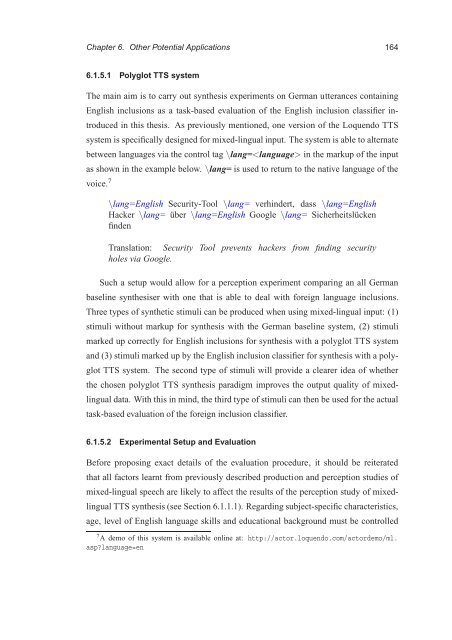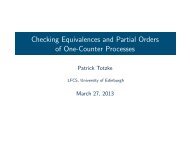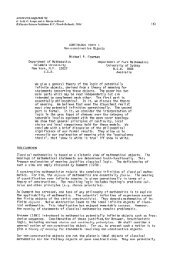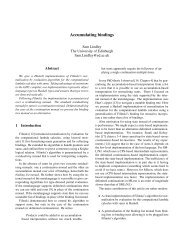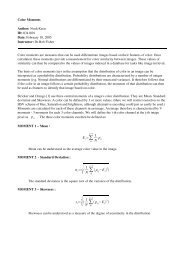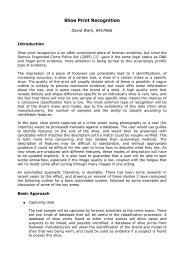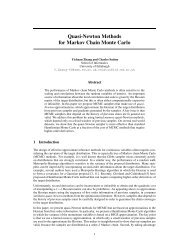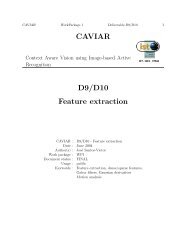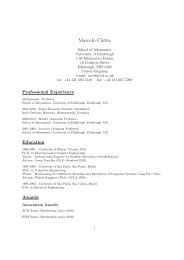PhD thesis - School of Informatics - University of Edinburgh
PhD thesis - School of Informatics - University of Edinburgh
PhD thesis - School of Informatics - University of Edinburgh
You also want an ePaper? Increase the reach of your titles
YUMPU automatically turns print PDFs into web optimized ePapers that Google loves.
Chapter 6. Other Potential Applications 164<br />
6.1.5.1 Polyglot TTS system<br />
The main aim is to carry out syn<strong>thesis</strong> experiments on German utterances containing<br />
English inclusions as a task-based evaluation <strong>of</strong> the English inclusion classifier in-<br />
troduced in this <strong>thesis</strong>. As previously mentioned, one version <strong>of</strong> the Loquendo TTS<br />
system is specifically designed for mixed-lingual input. The system is able to alternate<br />
between languages via the control tag \lang= in the markup <strong>of</strong> the input<br />
as shown in the example below. \lang= is used to return to the native language <strong>of</strong> the<br />
voice. 7<br />
\lang=English Security-Tool \lang= verhindert, dass \lang=English<br />
Hacker \lang= über \lang=English Google \lang= Sicherheitslücken<br />
finden<br />
Translation: Security Tool prevents hackers from finding security<br />
holes via Google.<br />
Such a setup would allow for a perception experiment comparing an all German<br />
baseline syn<strong>thesis</strong>er with one that is able to deal with foreign language inclusions.<br />
Three types <strong>of</strong> synthetic stimuli can be produced when using mixed-lingual input: (1)<br />
stimuli without markup for syn<strong>thesis</strong> with the German baseline system, (2) stimuli<br />
marked up correctly for English inclusions for syn<strong>thesis</strong> with a polyglot TTS system<br />
and (3) stimuli marked up by the English inclusion classifier for syn<strong>thesis</strong> with a poly-<br />
glot TTS system. The second type <strong>of</strong> stimuli will provide a clearer idea <strong>of</strong> whether<br />
the chosen polyglot TTS syn<strong>thesis</strong> paradigm improves the output quality <strong>of</strong> mixed-<br />
lingual data. With this in mind, the third type <strong>of</strong> stimuli can then be used for the actual<br />
task-based evaluation <strong>of</strong> the foreign inclusion classifier.<br />
6.1.5.2 Experimental Setup and Evaluation<br />
Before proposing exact details <strong>of</strong> the evaluation procedure, it should be reiterated<br />
that all factors learnt from previously described production and perception studies <strong>of</strong><br />
mixed-lingual speech are likely to affect the results <strong>of</strong> the perception study <strong>of</strong> mixed-<br />
lingual TTS syn<strong>thesis</strong> (see Section 6.1.1.1). Regarding subject-specific characteristics,<br />
age, level <strong>of</strong> English language skills and educational background must be controlled<br />
7 A demo <strong>of</strong> this system is available online at: http://actor.loquendo.com/actordemo/ml.<br />
asp?language=en


